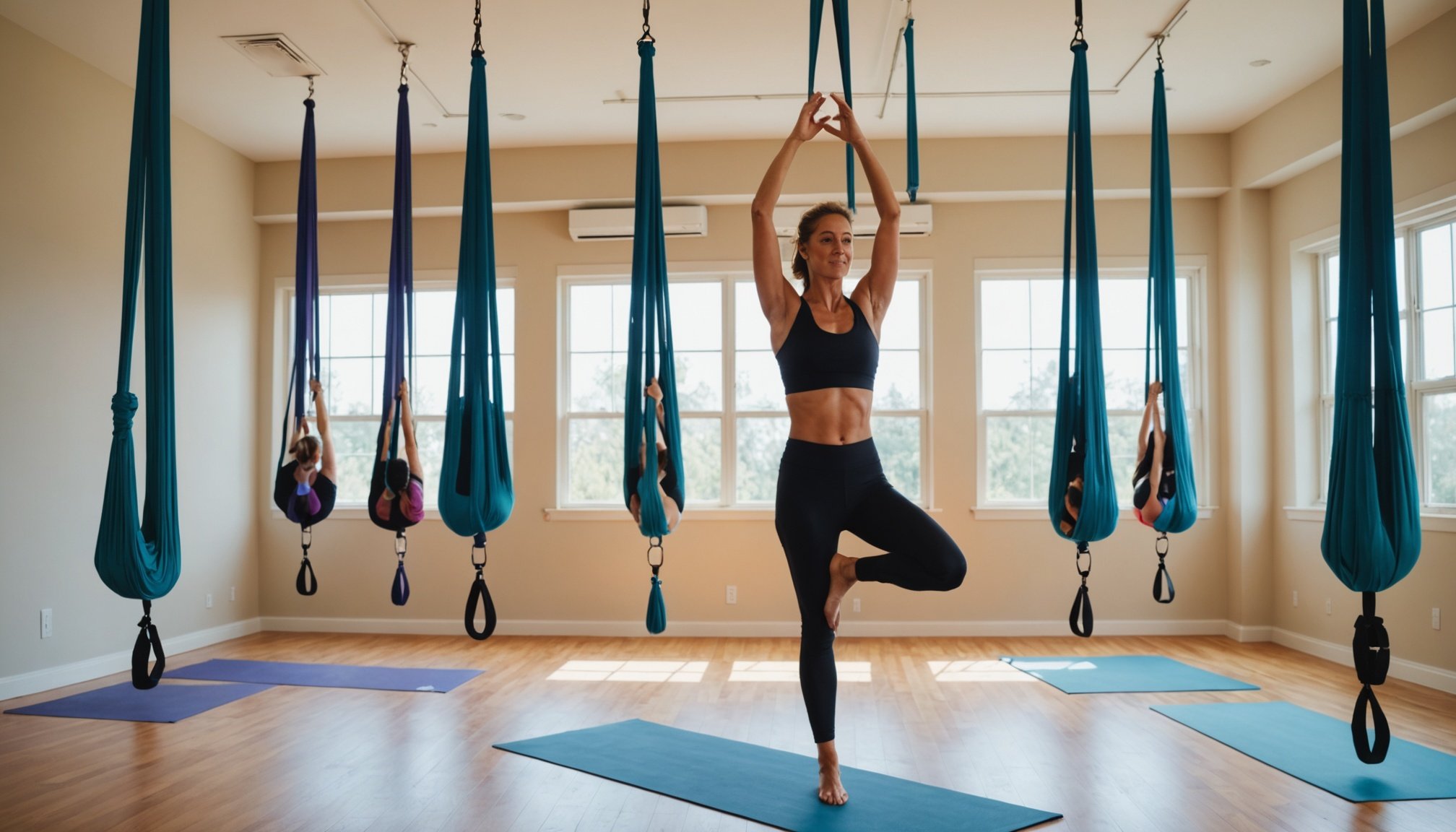Overview of Aerial Yoga
Incorporating elements of traditional yoga, aerial yoga offers a unique blend of flexibility and core strengthening, suspended in mid-air. Originating in the early 2000s, aerial yoga integrates acrobatic concepts with yoga, providing an innovative approach to fitness. Unlike traditional yoga, which is practiced solely on a mat, aerial yoga employs a soft, supportive fabric hammock suspended from the ceiling, allowing practitioners to explore new dimensions of movement and balance.
Aerial yoga benefits those seeking novel ways to stretch and strengthen muscles, as the hammock helps in executing poses with greater ease compared to floor-bound yoga. This enables deeper stretches and increased flexibility improvement. Additionally, the hammock offers a playful aspect, encouraging practitioners to overcome fear and embrace heights.
Also to discover : Discover the hidden benefits of intermittent fasting for optimal brain health
The introduction to aerial yoga typically involves familiarizing oneself with the hammock equipment and practicing foundational aerial yoga stretches and poses. Setups often vary, but a typical session requires a robust ceiling suspension with ample space for movement. Aerial yoga practices demand attention to safety, ensuring the equipment is supportive and properly installed, guaranteeing a fulfilling and secure yoga experience.
Benefits of Aerial Yoga for Flexibility
Aerial yoga offers an innovative approach to flexibility improvement, leveraging unique positions and poses that enhance body mobility. Suspended from a hammock, practitioners can experience deep stretches with less strain, thanks to gravity-assisted movements.
In the same genre : Unlocking healing: a deep dive into how narrative therapy transforms ptsd recovery for veterans
Aerial yoga stretches play a crucial role in targeting muscle groups that are otherwise difficult to stretch in traditional yoga. Poses such as the “inverted pigeon” or “hammock-assisted splits” enable joints and muscles to stretch with support, reducing the risk of injury. This ensures practitioners can safely explore their flexibility limits.
The physiological benefits of aerial yoga extend beyond mere flexibility. With consistent practice, participants may notice increased joint mobility and reduced muscle stiffness. This improvement is particularly beneficial for individuals seeking a gentle yet effective way to address flexibility issues.
Emphasizing the importance of a safe practice environment, aerial yoga encourages mindfulness. Mind-body awareness cultivated during these sessions aids relaxation, contributing to overall mental well-being. Adopting proper alignment techniques in aerial poses can heighten these benefits, offering a holistic approach to physical health and flexibility.
Aerial Yoga for Stress Relief and Mental Well-being
Engaging in aerial yoga presents an innovative approach to stress relief techniques, merging physical activity with mental rejuvenation. The connection between aerial yoga and reduced stress levels lies in its unique combination of movement and awareness. By practising aerial yoga, individuals are introduced to breathing techniques that enhance relaxation and promote mindfulness.
Within aerial yoga sessions, deep and rhythmic breathing exercises form a cornerstone, acting as a bridge to mental calm. These exercises are designed to focus the mind, encouraging practitioners to remain present and let go of external stressors. Breathing techniques intertwined with the poses help oxygenate the body and soothe the mind simultaneously.
Practitioners frequently share testimonials highlighting their mental well-being transformation through aerial yoga. Many describe a newfound sense of peace and clarity, attributing their mental health benefits to the practice’s mindful nature. As aerial yoga promotes both physical engagement and mental focus, it has become a popular choice for those seeking both physical enhancement and mental serenity. This mindfulness, nurtured through consistent practice, cultivates a holistic sense of well-being, offering sustained mental relaxation and resilience.
Techniques and Tips for Beginners
Embarking on your aerial yoga journey begins with understanding the essentials for beginner aerial yoga. Selecting the right equipment and ensuring a safe practice environment are fundamental. Aerial yoga requires a sturdy hammock, properly installed with reinforced ceiling hooks. It’s crucial to regularly check these components for wear and secure sewing, guaranteeing safe practices.
Essential Equipment and Setup
Ensure your aerial yoga setup includes not just the hammock, but also a spacious area to allow a full range of motion. Installing the hammock at the correct height—usually hip level when seated—is important for new poses and transitions. This precaution prevents discomfort and avoids potential injury.
Basic Aerial Yoga Poses
Starting with foundational aerial yoga tips, like the “aerial plank” and “cocoon,” helps build familiarity with the hammock. These poses encourage confidence as you gain experience and balance.
Common Mistakes to Avoid
One common mistake is overlooking safety measures. Regular equipment checks and considering professional installation minimize risks. Ensure the practice space is free from obstacles to prevent accidental bumps or slips, allowing you to focus on your newfound passion.
Transformative Experiences and Expert Insights
Aerial yoga isn’t just a practice; it’s a transformational journey for many. Personal stories often highlight how practitioners have not only enhanced their physical capabilities but also enriched their emotional resilience. One avid aerial yogi shared their experience of going from a reluctant novice to an enthusiast, attributing their success to supportive instructors and the empowering nature of aerial yoga.
Expert Insights
Instructors often note the profound impact aerial yoga has on their students’ lives. They observe improvements not just in flexibility and strength, but in students’ confidence and mental clarity. Experts emphasize the holistic benefits of the practice, noting how the combination of physical challenge and mental focus offers a balanced approach to wellness.
Evidence-Based Research
Research strengthens these anecdotes, revealing aerial yoga’s efficacy in improving both flexibility and mental health. Studies demonstrate significant improvements in balance and proprioception, key contributors to flexibility enhancement. Moreover, aerial yoga’s mindfulness component effectively reduces stress, promoting overall mental well-being. Together, these elements create a compelling case for integrating aerial yoga into one’s fitness and wellness routine.
Visual and Video Resources for Aerial Yoga
For those embarking on their aerial yoga journey, visual aids for learning play a crucial role in mastering new poses and techniques. Watching aerial yoga tutorials can significantly enhance understanding, especially for beginners who rely on observing intricate movements and transitions. Visual resources provide an accessible platform for exploring complex poses, making the learning curve less daunting.
Recommended Video Resources for Beginners
-
YouTube Channels: Platforms like YouTube host numerous aerial yoga demonstrations that cater to all skill levels. These videos often feature step-by-step instructions, offering guidance on maintaining proper alignment and safety.
-
Online Courses: Websites dedicated to yoga and fitness frequently provide structured courses. These courses are tailored for progression, allowing beginners to build on foundational skills while gaining confidence.
Enhancing Understanding Through Visuals
Incorporating visual learning not only aids in grasping pose intricacies but also clarifies proper usage of aerial yoga equipment. By observing skilled instructors, learners can visualize transitions between poses, understand weight distribution, and refine their techniques. Ultimately, these resources ease the learning process, helping enthusiasts achieve a deeper connection with their practice.











